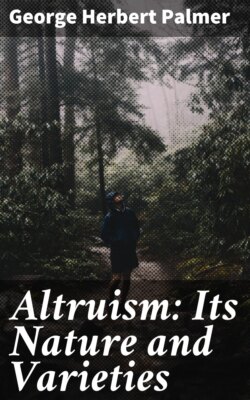Altruism: Its Nature and Varieties

Реклама. ООО «ЛитРес», ИНН: 7719571260.
Оглавление
George Herbert Palmer. Altruism: Its Nature and Varieties
Altruism: Its Nature and Varieties
Table of Contents
ALTRUISM. ITS NATURE AND VARIETIES
CHAPTER I. INTRODUCTION
CHAPTER II. MANNERS
CHAPTER III. GIFTS
CHAPTER IV. DEFECTS OF GIVING
CHAPTER V. MUTUALITY
CHAPTER VI. LOVE
CHAPTER VII. JUSTICE
CHAPTER VIII. CONCLUSION
Отрывок из книги
George Herbert Palmer
Published by Good Press, 2019
.....
Each of them looks upon man in his original estate as a self-centred being, a distinct ego. By degrees this single person discovers other persons about him and learns that he must have relations with them. The relations may be altruistic or egoistic, but they are subsequent and supplemental. In himself he is separate and detached. Now, I hold that this conception is altogether erroneous. There is no such solitary person. One person is no person. The smallest known unit of personality is three, father, mother, child. None of us came into the world in separateness, nor have separately remained here. Relations have encompassed us from birth. Through them we are what we are, social beings, members of a whole. While it is true that the ties of parentage loosen as the child matures, these drop away only because others, now more formative, take him in charge. Before we have a separate consciousness we know ourselves as members of a family, of a state, of the community of human kind. We never stand alone.
Not that it is an error to say “I.” This, properly, is our commonest word and commonest thought. Only with reference to it does anything else have value. However interlocked the total frame of things may be, at certain centres where relations converge there are unique spots of consciousness capable of estimating reality and of sending forth modifying influences. Such a centre of consciousness, unlike all else, we rightly call a person, a self or ego; and because of its importance we often fix attention on it, withdrawing notice for the moment from the relations which encompass it. Such an abstraction, if clearly understood, is entirely legitimate. I shall frequently make use of it under the title of the separate or abstract self. But it should be borne in mind that it is an abstraction and that the real person is what I shall call the conjunct or social self, made up of that centre of consciousness and the relations in which it stands. While these two are usefully distinguishable, they are not separable. When I try to detach myself from my surroundings I know I am attempting an impossibility. How much would there be left of me were there no one but this central ego, none with whom I might communicate, no language prepared for communication or thought, no common affections, interests, or undertakings? Evidently we are from the start social beings. If with the early moralists we make the opposite assumption, our subsequent interest in our fellow men will never quite clear itself of artificiality and mistake.
.....